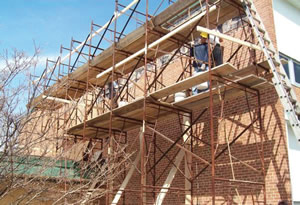Fix Them Now!
 Our nation’s children spend a great deal of time in the halls and on the campuses of our nation’s educational institutions. With most of their days spent in and around school facilities, students’ performance, health and morale are impacted by the state of the buildings and grounds they occupy.
Our nation’s children spend a great deal of time in the halls and on the campuses of our nation’s educational institutions. With most of their days spent in and around school facilities, students’ performance, health and morale are impacted by the state of the buildings and grounds they occupy.
The American Society of Civil Engineers’ 2013 Report Card for America’s Infrastructure gives our nation’s schools a grade of D. The average school facility is 48 years old and almost half of the public school buildings in use today were built to accommodate the baby boom generation, contributing to the poor marks.
Enrollment is up, and is projected to continue to rise, but spending on the nation’s public schools and universities has decreased. Even though experts estimate it will take at least $270 billion to maintain and modernize our school facilities, spending continues to drop. In 2012, spending on public school construction dropped to about half of what it was before the recession.
Whether due to inattention, inability or lack of available resources, the majority of the nation’s educational facilities are in dire need of repair, renovation or alteration. An investment in these buildings and campuses is an investment in the students and teachers that use them.
Health, performance linked to facility conditions
Students’ performance relies on a variety of factors, such as aptitude, motivation and morale, environment, attendance and alertness. The condition of our nation’s learning facilities can affect student performance in several of these areas.
A study on student performance and building conditions found a parallel between the amount of sunlight, or “daylighting” in classrooms, and the students’ performance on standardized math and reading tests. Students in classrooms that were the most exposed to windows or skylights that allowed more natural light to flow into the classroom had better math and reading scores than those who were exposed the least.
Proper heating, cooling and ventilation affects not only student performance, but their health, which may in turn affect their attendance and ability to keep up. Properly ventilated educational facilities have been found to reduce asthma symptoms and allergies. A focus on updating and maintaining an education facilities heating, cooling and ventilation units is shown to reduce asthma symptoms, which allows students to spend more time in school learning. Likewise, researchers at Lawrence Berkeley National Laboratories found that when ventilation rates are at or below minimum standards, student performance decreases by five to 10 percent as well.
Rapid response, timely repairs
School administrators have their work cut out for them. To solidify their deferred maintenance, repair and alteration strategies, school officials will need to support their projects with a construction procurement solution that minimizes wasted resources and brings reliable construction teams to get started on the long list of repair and renovation work to be done. The Job Order Contracting (JOC) construction procurement method allows procurement and facility professionals to access qualified contractors through a single contract that meets competitive bidding requirements. School districts are then able to complete an indefinite number of projects under the contract, eliminating the time and resources associated with bidding each individual project. A district’s needs may be vast, but by choosing an efficient and cost-effective procurement method such as Job Order Contracting, projects can begin quickly to alleviate some of the negative impacts of aging facilities.
Aging school facilities can impact health issues, and create inattention and low morale for the teachers and students who spend time in the buildings. Our nation’s education facilities are in critical shape, with 74 percent in need of immediate repair and replacement and another 12 percent labeled unsatisfactory or inadequate for learning. The JOC construction procurement process is a quicker, simpler way to tackle deferred maintenance work and accomplish repair and renovation projects, while adhering to the unique scheduling demands of education facilities.
This article originally appeared in the issue of .
About the Author
Randy Horn is the Western Region director of Operations for The Gordian Group, Inc. He has over 15 years of experience in the fields of program management and construction management, including public school systems, colleges and universities. He is responsible for developing and implementing programs in the West, including for the Los Angeles Unified School District, the second largest public school district in the country.